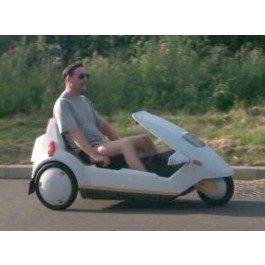The Sinclair C5 was first launched in the UK on the 10th January 1985. Created by the innovator and inventor Sir Clive Sinclair, most famous for his ZX80 and ZX81 personal computers from 1980, the C5 was a revolutionary electric vehicle weighing in at just 99lbs. The vehicle used a 33lb lead acid battery that powered a 250 watt Hoover electric motor similar to those found in washing machines. As the C5 was created to fall in line with the 1983 Electrically Assisted Pedal Cycle Regulations, this ruled that the vehicle’s engine could not exceed 250 watts in power. This therefore gave the C5 a top speed of 15 mph with a claimed 20 miles battery life in between charges. The vehicle also had pedals for extra assistance up hills. The body of the C5 was made of self-coloured lightweight polypropylene. The vehicle was 2ft 6” wide, 2ft 6” high and 5ft 9” long.
From day one of its launch the Sinclair C5 came under continuous attack from the media who criticised it for numerous reasons and said that it should be banned. The main reasons were that due to its low stance on the road it could not be seen easily by other road users, this also opened up the debate about C5 drivers being at the same level as exhaust pipes from larger vehicles and inhaling their fumes. In addition the C5’s power performance was also criticised as it was stated that often during independent test the vehicle could rarely tackle a hill climb without manual assistance peddling. It was also claimed that the vehicle only ever lasted approximately 10 miles on one battery charge and not the 20 specified by Sinclair. In some case this was reduced to 6 - 7 miles in winter as the cold would affect the battery’s performance. A high visibility mask was available for the C5 as an optional extra though many claimed it should have been standard. Despite most of these claims made by the media condemning the vehicle, RoSPA stated that they liked the C5 and that it should not be banned.
As a result of these problems the Sinclair quickly gained a bad reputation and interest in sales plummeted. The vehicle had originally been planned as a mail order vehicle and was sold on the high street through Electrical retailers. Due to the lack of sales prices fell to just £199 from the previous £399 in a bid to sell surplus stock. On the 15 October 1985, Sir Clive Sinclair announced that Sinclair Vehicles had officially been placed in the hands of the receiver four days earlier and production of the C5 ceased. Later Sinclair unveiled plans that they may be modified to make a C10 ( a two seater version) and a C15 (a four seater version.). It was also rumoured during the 1990’s that Sinclair was one of the People interested in the Reliant Motor Company when that went into receivership. Possibly with a plan to convert the Reliant Robin into an electric vehicle?



